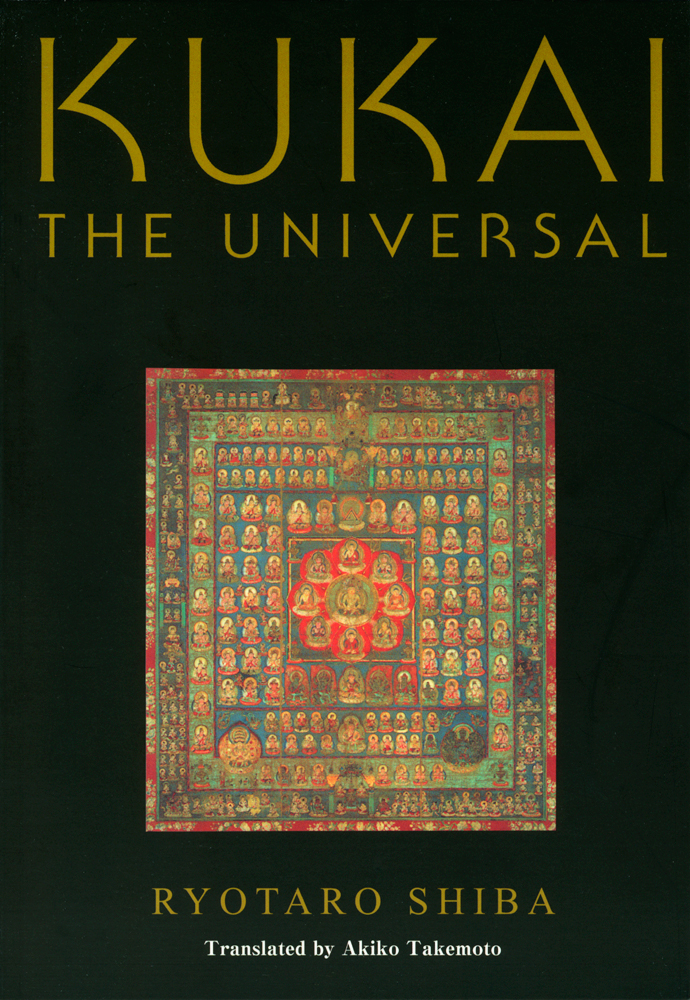ISBN:9784863870352、本体価格:2,000円
日本図書コード分類:C0093(一般/単行本/文学/日本文学小説)
350頁、寸法:151×218×19mm、重量535g
発刊:2013/07

【ACKNOWLEDGMENT】
...This may explain why Kukai looks so unique among all the historical figures Japan has ever produced. He was the only Japanese who had grown into a universal man, instead of remaining just a member of Japanese society....
In November, 1975, I had been pondering over this paragraph I was reading in the newly-published book on Kukai or the original text of this book-空海の風景(Kukai no Fukei).
Nearly twenty years had passed when in 1993 I finally felt ready to translate this book into English and wrote to the author, Shiba Ryotaro, about my intention. His prompt answer to allow me to“work freely on it”was thus to set Kukai free to meet people in general outside the sphere of Japanese language, even though Kukai: Major Works by Yoshito S. Hakeda(New York, Columbia University Press, 1971)had already been eagerly accepted by those who were interested in religion.
To our regret, Mr Shiba himself passed away in February, 1996, but the magnanimity he had shown me was thoughtfully respected by his Memorial Foundation, directed by his devoted wife, Mrs. Fukuda Midori.
Another person that helped me materialize this work was James Kirkup, an English poet and writer I had been corresponding since 1967 when he gave An Oral Interpretation of English Poetry at the annual assembly held in Tokyo by the National Federation for Teachers of English. No one could have been a better literary editor of this book than Mr. Kirkup, a cosmopolite equipped with comprehensive knowledge and insight into Japanese culture, past and present.
Among many others to whom I must express my special thanks there are: Yoritomi Motohiro: An active priest of Shingon religion, a distinguished scholar, writer and lecturer on various phases of Esoteric Buddhism. He, born in Sanuki as Kukai was, and the then President of Shuchi-in University in Kyoto, kindly answered my questions, introducing many useful books that were to guide me through the religious phase of this work. I had come to know of him in 1994 when he presided over a symposium on The Saint Kukai and His Messages to be Rediscovered for Today and Tomorrow.
Hasuo Zenryu: He who had been President of Zentsu-ji temple as Kukai's birthplace for thirty years (1970-1999) never failed to lead me to better understanding of Kukai not only through his writing but also through a personal contact I was honored to enjoy. But what helped me most, I now realize, was the very sight of him. It was always a revelation to me, for I was seeing in him a true disciple of Kukai.
As for the production and publication this time, the Representative Director, Mr. Ikegami Haruhide, Ms. Kimura Kazuyo and their staff of Bikohsha Company did their best, to my great satisfaction.
Takemoto Akiko
June 30, 2013
【TRANSLATOR'S NOTES】
1) British spelling is adopted in translating passages from Kukai's writings and other classical books or documents, e.g. honour, travelling, favour.
2) Personal names, Chinese and Japanese, are given in their native order with family name first.
3) Most Buddhist terms, names of Buddhist deities and titles of texts and books are given in their Japanese pronunciation, e.g. Shingon, Kannan, Kegonkyo. But those which form the core of Buddhism or Esoteric Buddhism are presented in Sanskrit though lacking diacritical marks, e.g. sunyata, homa, karma. The following are treated as English words: Buddha, bodhisattva, mandala, Mantrayana, mantra, mudra, sutra.
4) The months of the year are based on the old lunar calendar. In Japan it had been the official calendar until 1874 when the Gregorian calendar was adopted. According to the old calendar, the New Year, which occurred usually in February, was considered to be the beginning of spring which lasted three months, just like the other seasons.
5) People's ages are given in the old way of counting. In Japan until 1945 new-born babies were one year old during their first year, because the months before birth were taken into account.
6) An asterisk shows that the word or phrase or sentence will be explained later whether in the same chapter or in later chapters.
7) Many of the places mentioned will be found in the maps given on p.336-p.338.
8) Since the original was written for Japanese readers, who are supposed to be equipped with fundamental knowledge of Japanese history and its background, not a little explanation had to be added here and there in several chapters and their notes.
【CONTENTS】
Color Plates
Acknowledgment
Translator's Notes
I. THE BACKGROUND
II. BOYHOOD
III. AT THE TURNING POINT
IV. BEGGAR BOY
V. THE MORNING STAR FLEW INTO HIS MOUTH
INTERLUDE 1. THE ORIGIN OF ESOTERIC BUDDHISM
VI. PREPARATION FOR THE GREAT LEAP
VII. SAICHO
INTERLUDE 2. THE ENVOYS TO CHINA
VIII. THE BOATS TURNED BACK AND SET SAIL AGAIN
IX. DRIFTING ON WATER AND ON SHORE
X. HIS WRITING SAVED THE DIFFICULT SITUATIONS
XI. TRAVEL TO CHANG'AN
XII. SPRING IN CHANG'AN
XIII. A VARIETY OF THOUGHTS ON THE UNIVERSE
XIV. THE TWO INDIAN MASTERS AND ABBOT HUIGUO
XV. THE EIGHTH PATRIARCH OF ESOTERIC BUDDHISM
XVI. LEAVING CHANG'AN
XVII. RETURN TO JAPAN BY WAY OF YUEZHOU
XVIII. TWO YEARS ON MT.MAKINO'O
INTERLUDE 3. THE THREE IMPERIAL PRINCES
XIX. THOSE WHO SOUGHT HIS HELP
INTERLUDE 4. THE KUSUKO AFFAIR
XX. HIS NEWLY-ACQUIRED SELF-IDENTITY
XXL. AT OTOKUNI-DERA TEMPLE
XXII. THEIR EXPECTATIONS TURNED OUT TO BE UNFULFILLED
XXIII. HOW TO APPROACH THE TRUTH OF THE UNIVERSE
XXIV. THE LOGIC FOR ATTAINING BUDDHAHOOD BY MEANS OF TRUE WISDOM
XXV. WHAT SEPARATED KUKAI AND SAICH0
XXVI. CALLIGRAPHY
XXVII. HOW MOUNT K0YA STARTED
XXVIII. CONSUMMATING HIS THOUGHT AND ACTION
XXIX. THE BELIEF THAT THE DAISHI STILL EXISTS ON EARTH
XXX. THE WOOD HAS RUN OUT
Notes
Selected Bibliography for Translation
Bibliographical Index
Character Index
【著者紹介】
〔翻訳者〕
武本 明子
〔著者〕
司馬 遼太郎
【出版社から】
司馬遼太郎が書き記した空海を英語で読んでみませんか?他社で出版したものを復刻しました。